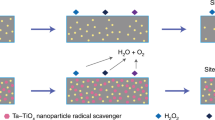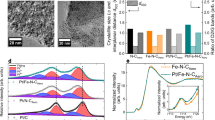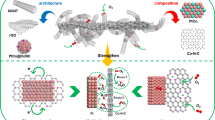Abstract
The development of novel substrates that possess high durability, strong anchoring to catalytic metal nanoparticles and low charge transfer resistance as well as that can replace conventional carbon is of great importance. To improve the durability and reduce the cost of various energy devices, new methodologies are necessary. Therefore, we report the preparation of a macroporous hybrid material containing polythiophene electropolymerized onto TiO2 nanotubes (TNT). The prepared foam-like hybrid material exhibited a very low charge transfer resistance and was further modified with novel and green photogenerated Pt nanoparticles. The material exhibited very strong metal substrate interactions, resulting in high durability during the oxygen reduction reaction (ORR). This study proposes a novel macroporous organic/inorganic hybrid material for use as an alternative material to replace conventional carbon substrates in ORR catalysts.
Similar content being viewed by others
Log in or create a free account to read this content
Gain free access to this article, as well as selected content from this journal and more on nature.com
or
References
Colón-Mercado HR, Popov BN. Stability of platinum based alloy cathode catalysts in PEM fuel cells. J Power Sources 2006;155:253–63.
Reiss P, Couderc E, De Girolamo J, Pron A. Conjugated polymers/semiconductor nanocrystals hybrid materials preparation, electrical transport properties and applications. Nanoscale 2011;3:446–89.
Naveen MH, Noh HB, Al Hossain MS, Kim JH, Shim YB. Facile potentiostatic preparation of functionalized polyterthiophene-anchored graphene oxide as a metal-free electrocatalyst for the oxygen reduction reaction. J Mater Chem A 2015;3:5426–33.
Kim DM, Shim KB, Son JI, Reddy SS, Shim YB. Spectroelectrochemical and electrochromic behaviors of newly synthesized poly [3′-(2-aminopyrimidyl)-2, 2′: 5′, 2 ′′-terthiophene]. Electrochim Acta 2013;104:322–29.
Rahman MA, Kumar P, Park DS, Shim YB. Electrochemical sensors based on organic conjugated polymers. Sensors 2008;8:118–41.
Lee TY, Shim YB. Direct DNA hybridization detection based on the oligonucleotide-functionalized conductive polymer. Anal Chem 2001;73:5629–32.
Schrebler R, Del Valle MA, Go H, Veas C, Co R. Preparation of polythiophene-modified electrodes by electrodeposition of Pt and Pt+Pb. Application to formic acid electro-oxidation. J Electroanal Chem 1995;380:219–27.
Yassar A, Roncali J, Garnier F. Preparation and electroactivity of poly (thiophene) electrodes modified by electrodeposition of palladium particles. J Electroanal Chem Interfacial Electrochem 1988;255:53–69.
Giacomini MT, Ticianelli EA, McBreen J, Balasubramanian M. Oxygen reduction on supported platinum/polythiophene electrocatalysts. J Electrochem Soc 2001;148:A323–A29.
Giacomini MT, Balasubramanian M, Khalid S, McBreen J, Ticianellia EA. Characterization of the activity of palladium-modified polythiophene electrodes for the hydrogen oxidation and oxygen reduction reactions. J Electrochem Soc 2003;150:A588–A93.
Wu D, Xu F, Sun B, Fu R, He H, Matyjaszewski K. Design and preparation of porous polymers. Chem Rev 2012;112:3959–4015.
Tian S, Wang J, Jonas U, Knoll W. Inverse opals of polyaniline and its copolymers prepared by electrochemical techniques. Chem Mater 2005;17:5726–30.
Döbbelin M, Tena‐Zaera R, Carrasco PM, Sarasua JR, Cabañero G, Mecerreyes D. Electrochemical synthesis of poly (3, 4-ethylenedioxythiophene) nanotube arrays using ZnO templates. J Polym Sci A Polym Chem 2010;48:4648–53.
Luo X, Killard AJ, Morrin A, Smyth MR. Electrochemical preparation of distinct polyaniline nanostructures by surface charge control of polystyrene nanoparticle templates. Chem Commun 2007;30:3207–09.
Cho SI, Lee SB. Fast electrochemistry of conductive polymer nanotubes: synthesis, mechanism, and application. Acc Chem Res 2008;41:699–707.
Kowalski D, Schmuki P. Polypyrrole self-organized nanopore arrays formed by controlled electropolymerization in TiO2 nanotube template. Chem Commun 2010;46:8585–7.
Pernites RB, Foster EL, Felipe MJL, Robinson M, Advincula RC. Patterned surfaces combining polymer brushes and conducting polymer via colloidal template electropolymerization. Adv Mater 2011;23:1287–92.
Li X, Dai L, Liu Y, Chen X, Yan W, Jiang L, Zhu J. Ionic-liquid-doped polyaniline inverse opals: preparation, characterization, and application for the electrochemical impedance immunoassay of hepatitis B surface antigen. Adv Funct Mater 2009;19:3120–8.
Park SA, Xiao R, Cho SI, Choi SJ, Lee SB, Kim SH, Kwon WJ, Son SJ, Kim J, Kim P. Nanotube-based ultrafast electrochromic display. Adv Mater 2005;17:171–5.
Xiao R, Cho SI, Liu R, Lee SB. Controlled electrochemical synthesis of conductive polymer nanotube structures. J Am Chem Soc 2007;129:4483–9.
Cho SI, Xiao R, Lee SB. Electrochemical synthesis of poly (3, 4-ethylenedioxythiophene) nanotubes towards fast window-type electrochromic devices. Nanotechnology 2007;18:405705.
Liu R, Cho SI, Lee SB. Poly (3, 4-ethylenedioxythiophene) nanotubes as electrode materials for a high-powered supercapacitor. Nanotechnology 2008;19:215710.
Zhu J, Liu Y, Dai L, Yan W, Chen X, Jiang L, Li X. Ionic-liquid-doped polyaniline inverse opals: preparation, characterization, and application for the electrochemical impedance immunoassay of hepatitis b surface antigen. Adv Funct Mater 2009;19:3120–8.
Kowalski D, Albu SP, Schmuki P. Current dependent formation of PEDOT inverse nanotube arrays. RSC Adv 2013;3:2154–7.
Ambade RB, Ambade SB, Shrestha NK, Nah YC, Han SH, Lee W, Lee SH. Polythiophene infiltrated TiO2 nanotubes as high-performance supercapacitor electrodes. Chem Commun 2013;49:2308–10.
Fall M, Aaron JJ, Sakmeche N, Dieng MM, Jouini M, Aeiyach S, Lacroix JC, Lacaze PC. Electrochemical and spectroscopic properties of poly (3-methoxythiophene) electrosynthesized in an aqueous micellar medium. Synth Met 1998;84:175–9.
Sakmeche N, Bazzaoui EA, Fall M, Aeiyach S, Jouini M, Lacroix JC, Aaron JJ, Lacaze PC. Application of sodium dodecylsulfate (SDS) micellar solution as an organized medium for electropolymerization of thiophene derivatives in water. Synth Met 1997;84:191–2.
Sakmeche N, Aaron JJ, Fall M, Aeiyach S, Jouini M, Lacroix JC, Lacaze PC. Anionic micelles; a new aqueous medium for electropolymerization of poly (3, 4-ethylenedioxythiophene) films on Pt electrodes. Chem Commun 1996;24:2723–4.
Sakmeche N, Aeiyach S, Aaron JJ, Jouini M, Lacroix JC, Lacaze PC. Improvement of the electrosynthesis and physicochemical properties of poly (3, 4-ethylenedioxythiophene) using a sodium dodecyl sulfate micellar aqueous medium. Langmuir 1999;15:2566–74.
Santoso HT, Singh V, Kalaitzidou K, Cola BA. Enhanced molecular order in polythiophene films electropolymerized in a mixed electrolyte of anionic surfactants and boron trifluoride diethyl etherate. Appl Mater Interfaces 2012;4:1697–703.
Pringle JM, Forsyth M, MacFarlane DR, Wagner K, Hall SB, Officer DL. The influence of the monomer and the ionic liquid on the electrochemical preparation of polythiophene. Polymer (Guildf) 2005;46:2047–58.
Deepa M, Ahmad S. Polypyrrole films electropolymerized from ionic liquids and in a traditional liquid electrolyte: a comparison of morphology and electro–optical properties. Eur Polym J 2008;44:3288–99.
Badam R, Vedarajan R, Okaya K, Matsutani K, Matsumi N. Sacrificial reducing agent free photo-generation of platinum nano particle over carbon/TiO2 for highly efficient oxygen reduction reaction. Sci Rep 2016;6:37006.
Dupont J, Consorti CS, Suarez PA, de Souza RF. Preparation of 1-butyl-3-methyl imidazolium-based room temperature ionic liquids. Org Synth. 2002;79:236.
Dong B, Li N, Zheng L, Yu L, Inoue T. Surface Adsorption and micelle formation of surface active ionic liquids in aqueous solution. Langmuir 2007;23:4178–82.
Jackson C, Smith GT, Inwood DW, Leach AS, Whalley PS, Callisti M, Polcar T, Russell AE, Levecque P, Kramer D. Electronic metal-support interaction enhanced oxygen reduction activity and stability of boron carbide supported platinum. Nat Commun 2017;8:15802.
Badam R, Vedarajan R, Matsumi N. Platinum decorated functionalized defective acetylene black; a promising cathode material for the oxygen reduction reaction. Chem Commun 2015;51:9841–44.
Cai F, Liang J, Tao Z, Chen J, Xu R. Low-Pt-loading acetylene-black cathode for high-efficient dye-sensitized solar cells. J Power Sources 2008;177:631–6.
Acknowledgements
R.B. is grateful for a MEXT scholarship from the Japanese government.
Author information
Authors and Affiliations
Corresponding author
Ethics declarations
Conflict of interest
The authors declare that they have no competing interests.
Electronic supplementary material
Rights and permissions
About this article
Cite this article
Badam, R., Vedarajan, R. & Matsumi, N. 3D-polythiophene foam on a TiO2 nanotube array as a substrate for photogenerated Pt nanoparticles as an advanced catalyst for the oxygen reduction reaction. Polym J 50, 213–220 (2018). https://doi.org/10.1038/s41428-017-0005-7
Received:
Revised:
Accepted:
Published:
Issue date:
DOI: https://doi.org/10.1038/s41428-017-0005-7
This article is cited by
-
Preparation of TiO2@Sn(Sb)O2 core–shell composites and their applications for electrocatalytic degradation of methylene blue
Journal of Materials Science: Materials in Electronics (2021)



